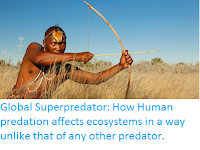Demand for natural resources from highly biodiverse tropical regions has expanded greatly increased in recent decades placing a great deal of stress on species living there. There are currently seven described species of non-Human Great Apes, the Chimpanzee, Pan troglodytes, the Bonobo, Pan paniscus, the Eastern Gorilla, Gorilla beringei, the Western Gorilla, Gorilla gorilla, the Sumatra Orangutan, Pongo abelii, the Tapanuli Orangutan, Pongo tapanuliensis, and the Borneo Orangutan, Pongo pygmaeus. All of these are classified as either Endangered or Critically Endangered under the terms of the the International Union for the Conservation of Nature's Red List of Threatened Species,
with the three Orangutan species, Asia's only Great Apes, considered to
be particularly at risk due to the rapid rate of deforestation in
Indonesia.
In a paper published in the journal Current Biology on 5 March 2015, a group of scientists led by Maria Voigt of the Max Planck Institute for Evolutionary Anthropology and the German Centre for Integrative Biodiversity Research publish the results of a study that monitored the decline in Borneo Orangutans between 1999 and 2015, and examine the causes of this decline.
Voigt et al. compiled the results of 1743 ground and aerial transects made between 1999 and 2015, which used observations of Orangutan nests as a proxy for Orangutan numbers. From these statistics they conclude that the three largest populations of Borneo Orangutans, Western Schwaner, Eastern Schwaner and Karangan suffered a total decline in Orangutan numbers of 148 500 numbers over the study period, with Western Schwaner losing 42 700 individuals, Eastern Schwaner 20 100 and Karangan 8200.
Surprisingly only about 9% of this total loss (i.e. 14 000 individuals) occurred in areas of extensive deforestation. There are two possible explanations for this, either Orangutans, which are intelligent, flexible animals, are better able to survive the loss of natural forest and the appearance of plantations for palm oil and paper pulp production than previously realised, or the population density of Orangutans in areas adjacent to plantations has risen sharply due to an influx of refugee animals, and is likely to drop sharply in the future due to an unsustainable high number of Apes.
Either way this also means that 91% of the loss (134 500 animals) occurred in areas not effected by major deforestation, indicating that there were more important factors at play. The strongest correlation with Orangutan population decline turned out to be rises in the Human population, strongly suggesting that Orangutans were dying principally as a result of being hunted, or other direct conflicts with Humans, such as the capture of young for the international pet trade (which also typically includes killing of the parents) or contracting Human diseases (known to be a significant cause of mortality in African Apes). Voigt et al. suggest that due to the low reproductive rate of Orangutans even a small increase in the mortality rate due to these causes could have a significant impact on the population.
See also...
Abundance of the Three Largest Orangutan Metapopulations between 1999 and 2015 and Projected Abundance for 2020 and 2050 Orangutan abundance was estimated for the three largest metapopulations with a multi-model approach over the study period (1999 to 2015). Estimates of future Orangutan abundance were based on forest cover projections for 2020 and 2050 and are indicated by a dashed line. Shaded areas and error bars represent the 95% confidence intervals. On the y axes, the number ‘10 000’ is highlighted in blue to show the scale difference between the three populations. The map shows all identified metapopulations in gray. The three largest metapopulations are indicated by their colour. State labels are as follows: Br, Brunei; Sb, Sabah; and Sk, Sarawak in Malaysia; WK, West; EK, East; NK, North; SK South; and CK, Central Kalimantan in Indonesia. Voigt et al. (2018).
Surprisingly only about 9% of this total loss (i.e. 14 000 individuals) occurred in areas of extensive deforestation. There are two possible explanations for this, either Orangutans, which are intelligent, flexible animals, are better able to survive the loss of natural forest and the appearance of plantations for palm oil and paper pulp production than previously realised, or the population density of Orangutans in areas adjacent to plantations has risen sharply due to an influx of refugee animals, and is likely to drop sharply in the future due to an unsustainable high number of Apes.
Either way this also means that 91% of the loss (134 500 animals) occurred in areas not effected by major deforestation, indicating that there were more important factors at play. The strongest correlation with Orangutan population decline turned out to be rises in the Human population, strongly suggesting that Orangutans were dying principally as a result of being hunted, or other direct conflicts with Humans, such as the capture of young for the international pet trade (which also typically includes killing of the parents) or contracting Human diseases (known to be a significant cause of mortality in African Apes). Voigt et al. suggest that due to the low reproductive rate of Orangutans even a small increase in the mortality rate due to these causes could have a significant impact on the population.
Baby Orangutans rescued from the pet trade being raised at a project run by International Animal Rescue in Borneo. Tim Laman/National Geographic.
See also...
Follow Sciency Thoughts on Facebook.









